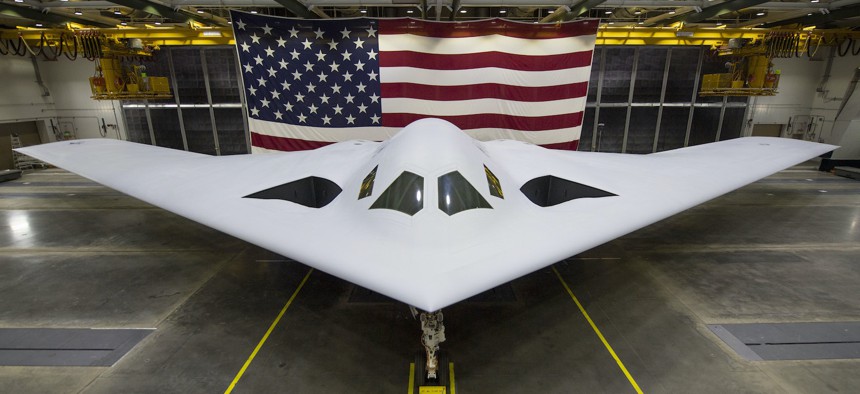
The B-21 Raider was unveiled to the public at a ceremony Dec. 2, 2022 in Palmdale, Calif. U.S. Air Force
Air Force wants to rely less on Northrop for B-21 sustainment
Stealth-bomber plans are part of a general effort to reduce costs by managing maintenance and upgrades.
DAYTON, Ohio—Air Force officials hope to keep the new B-21 stealth bomber affordable by depending less on builder Northrop Grumman to fix and update it.
The Raider program won't repeat a mistake it made on the B-2 Spirit program: relying too heavily on the contractor for sustainment, Brig. Gen. William Rogers, program executive officer for bombers, told reporters Monday.
“The way we initially were really contractor-focused for the B-2 and rely heavily on industry for the B-2—what were some of those things we could see that would have been better done [in] maybe an even more affordable way, if we did it organically?” Rogers said.
This approach to the B-21 Raider reflects a Pentagon-wide push for “organic sustainment”—essentially, handling more of the maintenance-and-upgrade work that had been handed to defense contractors on aircraft programs such as the B-2 and F-35.
The service is sharing “some of our lessons learned from B-2” so that “the B-21 doesn't repeat history in some of those areas,” he said.
Unveiled in December, the B-21 is expected to make its first flight later this year. Northrop said the B-21 achieved a “power-on milestone” in its second-quarter earnings call last week.
In March, Air Force Secretary Frank Kendall said that the Raider program still remains “within baseline,” but the schedule has slipped “by a few months.” He continued, “I hope we can hold that schedule.”
Meanwhile, Northrop CEO Kathy Warden said the company is expecting potential losses on the B-21 up to $1.2 billion due to inflation and pandemic-related economic pressures and will pull “every lever” to minimize the impact.
Out of the service’s $185.1 billion 2024 spending request, nearly $3 billion will go to the B-21 program. Service officials said the budget procures “more than one” B-21, but declined to say the exact number.
The Air Force envisions a future two-bomber force made up of B-21s and B-52 Stratofortess with new engines. The service plans to start cutting its B-1 and B-2 in the early 2030s, but there is “no hard set determined retirement date” for the programs, Rogers said.
“We’re still planning at some point they will retire somewhere once the B-21 is up and operational and my job as a PEO is to make sure that we keep them available, relevant, and give the Air Force senior leadership and our nation’s decision makers the flexibility to retire them gracefully if need be,” Rogers said.
Obsolescence and diminishing manufacturing sources is a major concern with the Air Force's aging bomber planes, he said, as the industrial base has “disappeared” for some of the B-52’s parts.
The Air Force is undergoing a massive B-52 re-engining effort, called the Commercial Engine Replacement Program, or CERP, which will replace the current Pratt & Whitney engine TF33, with new F130 Rolls Royce engines.
Rogers said the program is still on track to begin engineering and manufacturing development this fall and said the service aims to deliver the first test aircraft with the new engine in 2028.
Beyond the engine, CERP will bring other upgrades that will position the B-52 better to operate in the Pacific, Rogers said.
The program will give the B-52’s radar more processing power and upgrade its communications systems—as well as improve weapons integration, Rogers said.
“There is a lot of opportunity from the weapons perspective. We do have hypersonics. It is one of those platforms that is intended to carry hypersonic weapons, so that's where some of your anti-ship capabilities would come in along with the radar and additional range and additional power for the B-52,” he said.




